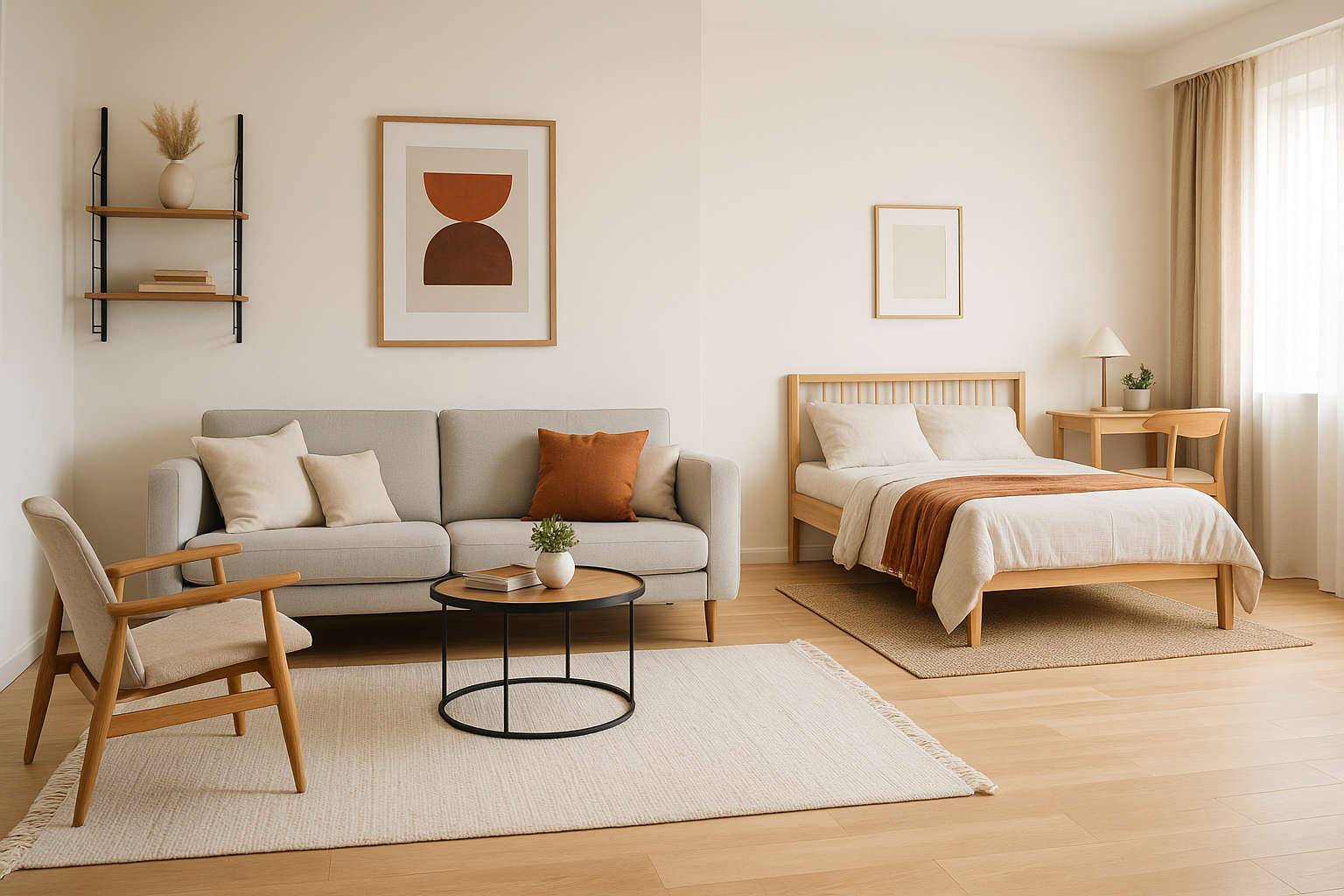In small apartments or open-concept homes, physical walls can be a luxury—or a limitation. When you don’t have the space (or permission, if you’re renting) to install partitions or build walls, rugs become one of the most powerful design tools at your disposal. They define areas, add texture, and create visual zones in a single gesture.
In this comprehensive guide, we’ll explore how to use rugs to define, organize, and beautify your space—without building a single wall.
Why Rugs Are So Effective in Small Spaces
Rugs are a versatile solution to multiple design challenges:
- Visually separate spaces in a studio or open-plan apartment
- Add warmth and texture
- Anchor furniture arrangements
- Soften acoustics
- Introduce color and pattern
When used intentionally, rugs become more than decor—they’re spatial organizers.
1. Understand Your Layout and Flow
Before placing any rug, assess your apartment’s layout:
- What functions does your space serve? (e.g., sleeping, working, relaxing, eating)
- Where do you need clearer boundaries between zones?
- How do you walk through your space?
A good rug layout supports movement while defining where one area begins and another ends.
2. Choose the Right Size for Each Zone
Using rugs that are too small is a common mistake, especially in tight spaces.
Living Area
- Rug should be large enough to fit at least the front legs of the sofa and chairs.
- It should extend beyond the coffee table to anchor the seating area.
Dining Area
- The rug should extend 60–75 cm (24–30 in) beyond the edges of the dining table so chairs stay on the rug even when pulled out.
Bedroom
- A large rug under the bed should extend at least 50–60 cm (20–24 in) around the sides and foot of the bed.
- Alternatively, place two smaller runners on either side.
Office Area
- A rug under a desk should cover the desk and chair area completely.
- This minimizes wear on the floor and adds comfort.
If you’re unsure, always size up. A larger rug makes a small room feel more expansive.
3. Use Color and Pattern Strategically
Neutral Rugs
- Make rooms feel calmer and more spacious.
- Ideal for minimalist or Scandinavian-inspired decor.
Patterned Rugs
- Help define zones clearly—great for visually separating a work-from-home setup from your living area.
- Patterns also hide dirt and wear, which is ideal for high-traffic areas.
Bright or Bold Rugs
- Add personality and can become a room’s focal point.
- Use in simpler spaces where the rug becomes the visual anchor.
Use contrasting styles to separate zones, or consistent patterns to unify them—depending on your design goal.
4. Layer Rugs for Texture and Flexibility
Rug layering is not just for large homes—done well, it adds richness to compact spaces too.
Try:
- A neutral jute rug as a base, with a smaller patterned rug layered on top.
- A cowhide or irregular-shaped rug layered over a square one to break visual monotony.
Layering can also help distinguish a micro-zone, such as a reading chair in a larger living room setup.
5. Define Specific Zones in Open Layouts
Living Room vs. Dining Room
Use two different rugs to clearly separate the living and dining zones. Choose complementary colors or textures, but different shapes or patterns to reinforce the boundary.
Bedroom + Office Combo
Place a plush rug under the bed and a flat-weave or patterned one under your desk to signal different uses for each part of the room.
Studio Apartment
- One rug for the sleeping area
- One for the living zone
- One under a desk or reading nook
This breaks the space visually and gives each function its place—without putting up any physical dividers.
6. Don’t Forget Rug Shape
While rectangular rugs are the most common, the shape of your rug can dramatically influence how your space feels.
Round Rugs
- Soften sharp angles in a square room
- Ideal for small dining sets or reading corners
- Can help create a “spotlight” effect
Runner Rugs
- Perfect for narrow spaces like entryways, hallways, or beside a bed
- Use runners to guide the eye and movement through the space
Square Rugs
- Great for symmetry in living rooms or under square tables
- Use when you want to create a sense of balance
The shape should match the furniture arrangement and the natural flow of movement.
7. Use Rugs to Add Comfort and Reduce Noise
Especially in apartments with hard floors (like tile or laminate), rugs serve functional purposes:
- Reduce echo and noise—great for shared walls and neighbors below
- Provide a soft surface for working or playing
- Keep your feet warm in winter
Choose thicker pile for bedrooms and lounges, flatweave for dining and office areas where chairs roll or pull.
8. Rug Pads Are a Must
No matter how small the space, rug pads serve several purposes:
- Keep rugs from sliding or bunching
- Add cushioning
- Protect floors from scratches
- Extend the life of your rug
For renters especially, rug pads can prevent damage to wood or vinyl flooring.
9. Coordinate with Other Textiles
Use rugs in harmony with:
- Curtains: Matching or complementary colors keep the space cohesive.
- Cushions and throws: Pick up accent colors from the rug.
- Upholstery: Use neutral or solid-color furniture to balance a bold rug.
This coordination helps create a sense of completeness in your interior design.
10. When One Rug Is Enough
Not every room needs multiple rugs. In very tight spaces:
- A single large rug can unify all functions in a studio.
- Place it under a bed and extend to the living zone, or under a central coffee table surrounded by all-purpose seating.
If adding more rugs makes the space feel chopped up, it’s better to go for one large, cohesive option.
Rugs offer an elegant, renter-friendly way to define zones, add texture, and enhance comfort in small homes. Whether you live in a studio, a 40m² apartment, or simply want a more open layout without permanent walls, the right rug can completely transform your space.
By playing with size, pattern, shape, and placement, you can visually organize your apartment while expressing your personal style—one layer at a time.

